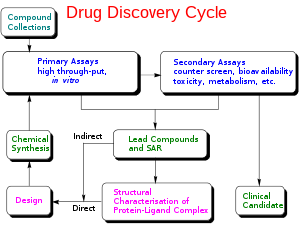Фармакология
| Фармакология | |
|---|---|
 Схематическое представление ванны органов, используемое для изучения эффекта изолированных тканей | |
| Сетка уникальный идентификатор | D010600 |
Фармакология - это наука о лекарствах и лекарствах , [ 1 ] включая происхождение вещества, композицию, фармакокинетику , фармакодинамику , терапевтическое использование и токсикологию . В частности, именно изучение взаимодействий, происходящих между живым организмом и химическими веществами, которые влияют на нормальную или ненормальную биохимическую функцию. [ 2 ] Если вещества обладают лекарственными свойствами, они считаются фармацевтическими препаратами .
Поле охватывает состав и свойства лекарственного средства, функции, источники, синтез и конструкцию лекарств , молекулярные и клеточные механизмы , механизмы органа/систем, передача сигналов/клеточная связь, молекулярная диагностика , взаимодействие , химическая биология , терапия и медицинские применения и антипатогенные способности. Двумя основными областями фармакологии являются фармакодинамика и фармакокинетика . Фармакодинамика изучает влияние препарата на биологические системы, и фармакокинетика изучает влияние биологических систем на лекарство. В широком смысле фармакодинамика обсуждает химические вещества с биологическими рецепторами , а в фармакокинетике обсуждаются поглощение , распределение, метаболизм и экскрецию (ADME) химических веществ из биологических систем.
Фармакология не является синонимом аптеки , и два термина часто путаются. Фармакология, биомедицинская наука , имеет дело с исследованиями, открытием и характеристикой химических веществ, которые показывают биологические эффекты и выяснение клеточной и организмальной функции в отношении этих химических веществ. Напротив, фармация, профессия здравоохранения, занимается применением принципов, полученных из фармакологии в ее клинических условиях; Будь то в роли дозирования или клинической помощи. В любой области основным контрастом между ними является их различие между уходом за прямым пациентом, аптечной практикой и научно-ориентированной областью исследований, обусловленной фармакологией.
Этимология
[ редактировать ]Слово фармакология получено из греческого слова φάρμακον , фармакона , означающего «наркотик» или « яд » вместе с другим греческим словом -λογία , со значением «изучения» или «знания» » [ 3 ] [ 4 ] (ср. Этимология фармации ). Pharmakon связан с фармакосами , ритуальной жертвой или изгнанием человеческого козла отпущения или жертвы в древнегреческой религии .
Современный термин Pharmacon используется более широко, чем термин препарат , потому что он включает эндогенные вещества, и биологически активные вещества, которые не используются в качестве лекарств. Как правило, он включает в себя фармакологические агонисты и антагонисты , а также ингибиторы ферментов (такие как ингибиторы моноаминоксидазы ). [ 5 ]
История
[ редактировать ]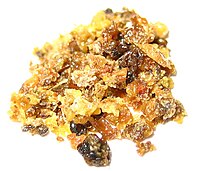

Происхождение клинической фармакологии восходит к средневековье , с фармакогнозией и Авиценной , « Канон медицины» комментарий Испании Петра по Исааку и Иоанна Святого Аманда комментарий о аннотарии Николая . [ 9 ] Ранняя фармакология была сосредоточена на травализме и природных веществах, в основном растительных экстрактов. Лекарства были составлены в книгах под названием Pharmacopoeias . С грубыми лекарствами использовались с момента предыстории в качестве приготовления веществ из природных источников. Тем не менее, активный ингредиент грубых препаратов не очищается, а вещество фальсифицируется другими веществами.
Традиционная медицина варьируется между культурами и может быть специфичной для конкретной культуры, например, в традиционной китайской , монгольской , тибетской и корейской медицине . Однако с тех пор многое из этого считалось ленинкой . Фармакологические вещества, известные как энтеогены, могут иметь духовное и религиозное использование и исторический контекст.
В 17 -м веке английский врач Николас Калпепер перевел и использовал фармакологические тексты. Culpeper детализировал растения и условия, которые они могли бы лечить. В 18 -м веке большая часть клинической фармакологии была создана работой Уильяма Уингерия . [ 10 ] Фармакология как научная дисциплина не продвигалась до середины 19-го века на фоне великого биомедицинского возрождения этого периода. [ 11 ] До второй половины девятнадцатого века замечательная эффективность и специфичность действий препаратов, таких как морфин , хинин и цифровой, были объяснены смутно и со ссылкой на необычайные химические способности и сродство к определенным органам или тканям. [ 12 ] Первый фармакологический факультет был создан Рудольфом Буххаймом в 1847 году в Университете Тарту, в знак признания необходимости понимать, как терапевтические препараты и яда дали их последствия. [ 11 ] Впоследствии первый фармакологический отдел в Англии был создан в 1905 году в Университетском колледже Лондона .
Фармакология, разработанная в 19 -м веке как биомедицинская наука, которая применяла принципы научных экспериментов к терапевтическим контекстам. [ 13 ] Содействие методам исследований продвигало фармакологические исследования и понимание. Развитие приготовления ванны органов , где образцы тканей связаны с записи, такие как миограф , и физиологические реакции регистрируются после применения лекарств, что позволило анализировать влияние лекарств на ткани. Разработка анализа связывания лиганда в 1945 году позволила количественно определять аффинность связывания лекарств в химических мишенях. [ 14 ] Современные фармакологи используют методы генетики , молекулярной биологии , биохимии и других передовых инструментов для преобразования информации о молекулярных механизмах и мишенях в терапию, направленные против болезней, дефектов или патогенных микроорганизмов, а также для создания методов профилактической помощи, диагностики и, в конечном итоге, персонализированной медицины .
Подразделения
[ редактировать ]Дисциплина фармакологии может быть разделена на многие субсципплины, каждая из которых с определенной целью.

Системы тела
[ редактировать ]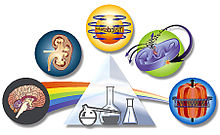
Фармакология может также сосредоточиться на конкретных системах, включающих организм. Отделы, связанные с телесными системами, изучают влияние лекарств в различных системах организма. К ним относятся нейрофармакология , в центральной и периферической нервной системы ; Иммунофармакология в иммунной системе. Другие подразделения включают сердечно -сосудистые , почечные и эндокринные фармакологии. Психофармакология - это изучение использования лекарств, которые влияют на психику , разум и поведение (например, антидепрессанты) при лечении психических расстройств (например, депрессия). [ 15 ] [ 16 ] Он включает в себя подходы и методы нейрофармакологии, поведения животных и поведенческой нейробиологии, и интересуется поведенческими и нейробиологическими механизмами действия психоактивных препаратов. [ Цитация необходима ] Связанная область нейропсихофармакологии фокусируется на воздействии лекарств на совпадение между нервной системой и психикой.
Фармакометаболомика , также известная как Pharmacometabonomics, представляет собой поле, которое связано с метаболомикой , количественной оценкой и анализом метаболитов , продуцируемых организмом. [ 17 ] [ 18 ] прямому измерению метаболитов в телесных жидкостях человека, чтобы предсказать или оценить метаболизм фармацевтических Это относится к соединений и лучше понять фармакокинетический профиль препарата. [17][18] Pharmacometabolomics can be applied to measure metabolite levels following the administration of a drug, in order to monitor the effects of the drug on metabolic pathways. Pharmacomicrobiomics studies the effect of microbiome variations on drug disposition, action, and toxicity.[19] Pharmacomicrobiomics is concerned with the interaction between drugs and the gut microbiome. Pharmacogenomics is the application of genomic technologies to drug discovery and further characterization of drugs related to an organism's entire genome.[citation needed] For pharmacology regarding individual genes, pharmacogenetics studies how genetic variation gives rise to differing responses to drugs.[citation needed] Pharmacoepigenetics studies the underlying epigenetic marking patterns that lead to variation in an individual's response to medical treatment.[20]
Clinical practice and drug discovery
[edit]
Pharmacology can be applied within clinical sciences. Clinical pharmacology is the application of pharmacological methods and principles in the study of drugs in humans.[21] An example of this is posology, which is the study of how medicines are dosed.[22]
Pharmacology is closely related to toxicology. Both pharmacology and toxicology are scientific disciplines that focus on understanding the properties and actions of chemicals.[23] However, pharmacology emphasizes the therapeutic effects of chemicals, usually drugs or compounds that could become drugs, whereas toxicology is the study of chemical's adverse effects and risk assessment.[23]
Pharmacological knowledge is used to advise pharmacotherapy in medicine and pharmacy.
Drug discovery
[edit]This article may contain an excessive amount of intricate detail that may interest only a particular audience. (July 2019) |
Drug discovery is the field of study concerned with creating new drugs. It encompasses the subfields of drug design and development.[24] Drug discovery starts with drug design, which is the inventive process of finding new drugs.[25] In the most basic sense, this involves the design of molecules that are complementary in shape and charge to a given biomolecular target.[26] After a lead compound has been identified through drug discovery, drug development involves bringing the drug to the market.[24] Drug discovery is related to pharmacoeconomics, which is the sub-discipline of health economics that considers the value of drugs[27][28] Pharmacoeconomics evaluates the cost and benefits of drugs in order to guide optimal healthcare resource allocation.[29] The techniques used for the discovery, formulation, manufacturing and quality control of drugs discovery is studied by pharmaceutical engineering, a branch of engineering.[30] Safety pharmacology specialises in detecting and investigating potential undesirable effects of drugs.[31]
Development of medication is a vital concern to medicine, but also has strong economical and political implications. To protect the consumer and prevent abuse, many governments regulate the manufacture, sale, and administration of medication. In the United States, the main body that regulates pharmaceuticals is the Food and Drug Administration; they enforce standards set by the United States Pharmacopoeia. In the European Union, the main body that regulates pharmaceuticals is the EMA, and they enforce standards set by the European Pharmacopoeia.
The metabolic stability and the reactivity of a library of candidate drug compounds have to be assessed for drug metabolism and toxicological studies. Many methods have been proposed for quantitative predictions in drug metabolism; one example of a recent computational method is SPORCalc.[32] A slight alteration to the chemical structure of a medicinal compound could alter its medicinal properties, depending on how the alteration relates to the structure of the substrate or receptor site on which it acts: this is called the structural activity relationship (SAR). When a useful activity has been identified, chemists will make many similar compounds called analogues, to try to maximize the desired medicinal effect(s). This can take anywhere from a few years to a decade or more, and is very expensive.[33] One must also determine how safe the medicine is to consume, its stability in the human body and the best form for delivery to the desired organ system, such as tablet or aerosol. After extensive testing, which can take up to six years, the new medicine is ready for marketing and selling.[33]
Because of these long timescales, and because out of every 5000 potential new medicines typically only one will ever reach the open market, this is an expensive way of doing things, often costing over 1 billion dollars. To recoup this outlay pharmaceutical companies may do a number of things:[33]
- Carefully research the demand for their potential new product before spending an outlay of company funds.[33]
- Obtain a patent on the new medicine preventing other companies from producing that medicine for a certain allocation of time.[33]
The inverse benefit law describes the relationship between a drugs therapeutic benefits and its marketing.
When designing drugs, the placebo effect must be considered to assess the drug's true therapeutic value.
Drug development uses techniques from medicinal chemistry to chemically design drugs. This overlaps with the biological approach of finding targets and physiological effects.
Wider contexts
[edit]Pharmacology can be studied in relation to wider contexts than the physiology of individuals. For example, pharmacoepidemiology concerns the variations of the effects of drugs in or between populations, it is the bridge between clinical pharmacology and epidemiology.[34][35] Pharmacoenvironmentology or environmental pharmacology is the study of the effects of used pharmaceuticals and personal care products (PPCPs) on the environment after their elimination from the body.[36] Human health and ecology are intimately related so environmental pharmacology studies the environmental effect of drugs and pharmaceuticals and personal care products in the environment.[37]
Drugs may also have ethnocultural importance, so ethnopharmacology studies the ethnic and cultural aspects of pharmacology.[38]
Emerging fields
[edit]Photopharmacology is an emerging approach in medicine in which drugs are activated and deactivated with light. The energy of light is used to change for shape and chemical properties of the drug, resulting in different biological activity.[39] This is done to ultimately achieve control when and where drugs are active in a reversible manner, to prevent side effects and pollution of drugs into the environment.[40][41]
Theory of pharmacology
[edit]This section needs expansion. You can help by adding to it. (July 2019) |
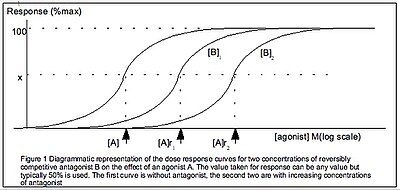
The study of chemicals requires intimate knowledge of the biological system affected. With the knowledge of cell biology and biochemistry increasing, the field of pharmacology has also changed substantially. It has become possible, through molecular analysis of receptors, to design chemicals that act on specific cellular signaling or metabolic pathways by affecting sites directly on cell-surface receptors (which modulate and mediate cellular signaling pathways controlling cellular function).
Chemicals can have pharmacologically relevant properties and effects. Pharmacokinetics describes the effect of the body on the chemical (e.g. half-life and volume of distribution), and pharmacodynamics describes the chemical's effect on the body (desired or toxic).
Systems, receptors and ligands
[edit]This section needs expansion. You can help by adding to it. (July 2019) |
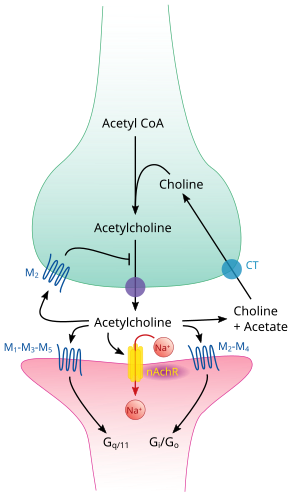
Pharmacology is typically studied with respect to particular systems, for example endogenous neurotransmitter systems. The major systems studied in pharmacology can be categorised by their ligands and include acetylcholine, adrenaline, glutamate, GABA, dopamine, histamine, serotonin, cannabinoid and opioid.
Molecular targets in pharmacology include receptors, enzymes and membrane transport proteins. Enzymes can be targeted with enzyme inhibitors. Receptors are typically categorised based on structure and function. Major receptor types studied in pharmacology include G protein coupled receptors, ligand gated ion channels and receptor tyrosine kinases.
Network pharmacology is a subfield of pharmacology that combines principles from pharmacology, systems biology, and network analysis to study the complex interactions between drugs and targets (e.g., receptors or enzymes etc.) in biological systems. The topology of a biochemical reaction network determines the shape of drug dose-response curve[42] as well as the type of drug-drug interactions,[43] thus can help designing efficient and safe therapeutic strategies. The topology Network pharmacology utilizes computational tools and network analysis algorithms to identify drug targets, predict drug-drug interactions, elucidate signaling pathways, and explore the polypharmacology of drugs.
Pharmacodynamics
[edit]This section needs additional citations for verification. (November 2023) |
Pharmacodynamics is defined as how the body reacts to the drugs. Pharmacodynamics theory often investigates the binding affinity of ligands to their receptors. Ligands can be agonists, partial agonists or antagonists at specific receptors in the body. Agonists bind to receptors and produce a biological response, a partial agonist produces a biological response lower than that of a full agonist, antagonists have affinity for a receptor but do not produce a biological response.
The ability of a ligand to produce a biological response is termed efficacy, in a dose-response profile it is indicated as percentage on the y-axis, where 100% is the maximal efficacy (all receptors are occupied).
Binding affinity is the ability of a ligand to form a ligand-receptor complex either through weak attractive forces (reversible) or covalent bond (irreversible), therefore efficacy is dependent on binding affinity.
Potency of drug is the measure of its effectiveness, EC50 is the drug concentration of a drug that produces an efficacy of 50% and the lower the concentration the higher the potency of the drug therefore EC50 can be used to compare potencies of drugs.
Medication is said to have a narrow or wide therapeutic index, certain safety factor or therapeutic window. This describes the ratio of desired effect to toxic effect. A compound with a narrow therapeutic index (close to one) exerts its desired effect at a dose close to its toxic dose. A compound with a wide therapeutic index (greater than five) exerts its desired effect at a dose substantially below its toxic dose. Those with a narrow margin are more difficult to dose and administer, and may require therapeutic drug monitoring (examples are warfarin, some antiepileptics, aminoglycoside antibiotics). Most anti-cancer drugs have a narrow therapeutic margin: toxic side-effects are almost always encountered at doses used to kill tumors.
The effect of drugs can be described with Loewe additivity which is one of several common reference models.[43]
Other models include the Hill equation, Cheng-Prusoff equation and Schild regression.
Pharmacokinetics
[edit]This section has multiple issues. Please help improve it or discuss these issues on the talk page. (Learn how and when to remove these messages)
|
Pharmacokinetics is the study of the bodily absorption, distribution, metabolism, and excretion of drugs.[44]
When describing the pharmacokinetic properties of the chemical that is the active ingredient or active pharmaceutical ingredient (API), pharmacologists are often interested in L-ADME:
- Liberation – How is the API disintegrated (for solid oral forms (breaking down into smaller particles), dispersed, or dissolved from the medication?
- Absorption – How is the API absorbed (through the skin, the intestine, the oral mucosa)?
- Distribution – How does the API spread through the organism?
- Metabolism – Is the API converted chemically inside the body, and into which substances. Are these active (as well)? Could they be toxic?
- Excretion – How is the API excreted (through the bile, urine, breath, skin)?
Drug metabolism is assessed in pharmacokinetics and is important in drug research and prescribing.
Pharmacokinetics is the movement of the drug in the body, it is usually described as 'what the body does to the drug' the physico-chemical properties of a drug will affect the rate and extent of absorption, extent of distribution, metabolism and elimination. The drug needs to have the appropriate molecular weight, polarity etc. in order to be absorbed, the fraction of a drug the reaches the systemic circulation is termed bioavailability, this is simply a ratio of the peak plasma drug levels after oral administration and the drug concentration after an IV administration(first pass effect is avoided and therefore no amount drug is lost). A drug must be lipophilic (lipid soluble) in order to pass through biological membranes this is true because biological membranes are made up of a lipid bilayer (phospholipids etc.) Once the drug reaches the blood circulation it is then distributed throughout the body and being more concentrated in highly perfused organs.
Administration, drug policy and safety
[edit]Drug policy
[edit]In the United States, the Food and Drug Administration (FDA) is responsible for creating guidelines for the approval and use of drugs. The FDA requires that all approved drugs fulfill two requirements:
- The drug must be found to be effective against the disease for which it is seeking approval (where 'effective' means only that the drug performed better than placebo or competitors in at least two trials).
- The drug must meet safety criteria by being subject to animal and controlled human testing.
Gaining FDA approval usually takes several years. Testing done on animals must be extensive and must include several species to help in the evaluation of both the effectiveness and toxicity of the drug. The dosage of any drug approved for use is intended to fall within a range in which the drug produces a therapeutic effect or desired outcome.[45]
The safety and effectiveness of prescription drugs in the U.S. are regulated by the federal Prescription Drug Marketing Act of 1987.
The Medicines and Healthcare products Regulatory Agency (MHRA) has a similar role in the UK.
Medicare Part D is a prescription drug plan in the U.S.
The Prescription Drug Marketing Act (PDMA) is an act related to drug policy.
Prescription drugs are drugs regulated by legislation.
Societies and education
[edit]Societies and administration
[edit]The International Union of Basic and Clinical Pharmacology, Federation of European Pharmacological Societies and European Association for Clinical Pharmacology and Therapeutics are organisations representing standardisation and regulation of clinical and scientific pharmacology.
Systems for medical classification of drugs with pharmaceutical codes have been developed. These include the National Drug Code (NDC), administered by Food and Drug Administration.;[46] Drug Identification Number (DIN), administered by Health Canada under the Food and Drugs Act; Hong Kong Drug Registration, administered by the Pharmaceutical Service of the Department of Health (Hong Kong) and National Pharmaceutical Product Index in South Africa. Hierarchical systems have also been developed, including the Anatomical Therapeutic Chemical Classification System (AT, or ATC/DDD), administered by World Health Organization; Generic Product Identifier (GPI), a hierarchical classification number published by MediSpan and SNOMED, C axis. Ingredients of drugs have been categorised by Unique Ingredient Identifier.
Education
[edit]The study of pharmacology overlaps with biomedical sciences and is the study of the effects of drugs on living organisms. Pharmacological research can lead to new drug discoveries, and promote a better understanding of human physiology. Students of pharmacology must have a detailed working knowledge of aspects in physiology, pathology, and chemistry. They may also require knowledge of plants as sources of pharmacologically active compounds.[38] Modern pharmacology is interdisciplinary and involves biophysical and computational sciences, and analytical chemistry. A pharmacist needs to be well-equipped with knowledge on pharmacology for application in pharmaceutical research or pharmacy practice in hospitals or commercial organisations selling to customers. Pharmacologists, however, usually work in a laboratory undertaking research or development of new products. Pharmacological research is important in academic research (medical and non-medical), private industrial positions, science writing, scientific patents and law, consultation, biotech and pharmaceutical employment, the alcohol industry, food industry, forensics/law enforcement, public health, and environmental/ecological sciences. Pharmacology is often taught to pharmacy and medicine students as part of a Medical School curriculum.
See also
[edit]References
[edit]- ^ Vallance P, Smart TG (January 2006). "The future of pharmacology". British Journal of Pharmacology. 147 Suppl 1 (S1): S304–7. doi:10.1038/sj.bjp.0706454. PMC 1760753. PMID 16402118.
- ^ "Definition of PHARMACOLOGY". Merriam-Webster. Retrieved 28 February 2023.
- ^ "Pharmacy (n.)". Online Etymology Dictionary. Archived from the original on 2 October 2017. Retrieved 18 May 2017.
- ^ "Pharmacology". Online Etymology Dictionary. Archived from the original on 2 October 2017. Retrieved 18 May 2017.
- ^ Takács-Novák, K.; Avdeef, A. (August 1996). "Interlaboratory study of log P determination by shake-flask and potentiometric methods". Journal of Pharmaceutical and Biomedical Analysis. 14 (11): 1405–13. doi:10.1016/0731-7085(96)01773-6. PMID 8877846.
- ^ Kritikos PG, Papadaki SP (1 January 1967). "The early history of the poppy and opium". Journal of the Archaeological Society of Athens.
- ^ Luch A, ed. (2009). Molecular, clinical and environmental toxicology. Springer. p. 20. ISBN 978-3-7643-8335-0. Archived from the original on 6 August 2020. Retrieved 21 July 2020.
- ^ Sertürner F (1805). "Untitled letter to the editor". Journal der Pharmacie für Aerzte, Apotheker und Chemisten (Journal of Pharmacy for Physicians, Apothecaries, and Chemists). 13: 229–243. Archived from the original on 17 August 2016.; see especially "III. Säure im Opium" (acid in opium), pp. 234–235, and "I. Nachtrag zur Charakteristik der Säure im Opium" (Addendum on the characteristics of the acid in opium), pp. 236–241.
- ^ Brater DC, Daly WJ (May 2000). "Clinical pharmacology in the Middle Ages: principles that presage the 21st century". Clinical Pharmacology and Therapeutics. 67 (5): 447–50. doi:10.1067/mcp.2000.106465. PMID 10824622. S2CID 45980791.
- ^ Hollinger MA (2003). Introduction to pharmacology. CRC Press. p. 4. ISBN 0-415-28033-8. Archived from the original on 17 April 2021. Retrieved 27 June 2015.
- ^ Jump up to: a b Rang HP (January 2006). "The receptor concept: pharmacology's big idea". British Journal of Pharmacology. 147 Suppl 1 (S1): S9-16. doi:10.1038/sj.bjp.0706457. PMC 1760743. PMID 16402126.
- ^ Maehle AH, Prüll CR, Halliwell RF (August 2002). "The emergence of the drug receptor theory". Nature Reviews. Drug Discovery. 1 (8): 637–41. doi:10.1038/nrd875. PMID 12402503. S2CID 205479063.
- ^ Rang HP, Dale MM, Ritter JM, Flower RJ (2007). Фармакология . Китай : Elsevier . ISBN 978-0-443-06911-6 .
- ^ Масуд Н. Хан; Джон У. Финдли, ред. (2009). Лиганд-связывающие анализы разработка, валидация и реализация на арене разработки лекарств . Хобокен, Нью -Джерси: Джон Вили и сыновья. ISBN 978-0470541494 .
- ^ «Психофармакология | Психология сегодня международной» . Psychologytoday.com . Архивировано из оригинала 24 февраля 2022 года . Получено 23 июля 2020 года .
- ^ «Что такое психофармакология» . ascpp.org . 29 ноября 2012 года. Архивировано с оригинала 23 июля 2020 года . Получено 23 июля 2020 года .
- ^ Jump up to: а беременный Каддура-Даук Р., Кристал Б.С., Вайншилбум Р.М. (2008). «Метаболомика: глобальный биохимический подход к реакции на наркотики и болезнях». Ежегодный обзор фармакологии и токсикологии . 48 : 653–83. doi : 10.1146/annurev.pharmtox.48.113006.094715 . PMID 18184107 .
- ^ Jump up to: а беременный Каддура-Даук Р., Вайншилбум Р.М. (февраль 2014 г.). «Фармакометаболомика: последствия для клинической фармакологии и системной фармакологии». Клиническая фармакология и терапия . 95 (2): 154–67. doi : 10.1038/clpt.2013.217 . PMID 24193171 . S2CID 22649568 .
- ^ Rizkallah MR, Saad R, Aziz RK (сентябрь 2010 г.). «Проект микробиома человека, персонализированная медицина и рождение фармакомикробиомики». Текущая фармакогеномика и персонализированная медицина . 8 (3): 182–93. doi : 10.2174/187569210792246326 .
- ^ Гомес А., Ингелман-Сандберг М (апрель 2009 г.). «Фармакоэпигенетика: его роль в межиндивидуальных различиях в реакции на лекарства». Клиническая фармакология и терапия . 85 (4): 426–30. doi : 10.1038/clpt.2009.2 . PMID 19242404 . S2CID 39131071 .
- ^ "Что такое клиническая фармакология?" Полем ascpt.org . Архивировано из оригинала 31 октября 2021 года . Получено 31 октября 2021 года .
- ^ «Позология, факторы, влияющие на дозу, расчет доз» . Pharmamad.com . 23 января 2019 года. Архивировано с оригинала 31 октября 2021 года . Получено 31 октября 2021 года .
- ^ Jump up to: а беременный «Наука о фармакологии и токсикологии» . Медицинский факультет, Университет Торонто. Архивировано из оригинала 16 июля 2019 года . Получено 16 июля 2019 года .
- ^ Jump up to: а беременный «Разработка наркотиков» . SciEndirect.com . 2013. Архивировано с оригинала 31 октября 2021 года . Получено 31 октября 2021 года .
- ^ Madsen U, Krogsgaard-Larsen P, Liljefors TV (2002). Учебник по дизайну наркотиков и обнаружения . Вашингтон, округ Колумбия: Тейлор и Фрэнсис. ISBN 978-0-415-28288-8 .
- ^ «Введение в дизайн лекарств» (PDF) . Архивировано (PDF) из оригинала 31 октября 2021 года . Получено 31 октября 2021 года .
- ^ Мюллер С., Шур С., О'Коннелл Дж (октябрь 1997). «Расходы на рецептурные препараты: влияние возраста и статуса хронического заболевания» . Американский журнал общественного здравоохранения . 87 (10): 1626–9. doi : 10.2105/ajph.87.10.1626 . PMC 1381124 . PMID 9357343 .
- ^ Арнольд Р.Дж., Экинс С. (2010). «Время для сотрудничества в области экономики здравоохранения среди модельного сообщества». Фармакоэкономика . 28 (8): 609–13. doi : 10.2165/11537580-000000000-00000 . PMID 20513161 . S2CID 23088517 .
- ^ «Фармакоэкономика - обзор» . SciEndirect.com . Архивировано из оригинала 31 октября 2021 года . Получено 31 октября 2021 года .
- ^ Reklaitis GV, Khinast J, Muzzio F (ноябрь 2010). «Наука фармацевтической инженерии - новые подходы к фармацевтическому развитию и производству». Химическая инженерия . 65 (21): iv - vii. Bibcode : 2010Chens..65d ... 4r . doi : 10.1016/j.ces.2010.08.041 .
- ^ Хайт, Марк (25 июня 2016 года). «Подходы фармакологии безопасности» . Международный журнал токсикологии . 16 : 23–32. doi : 10.1080/109158197227332 . S2CID 71986376 .
- ^ Смит Дж., Стейн V (апрель 2009 г.). «SporCalc: разработка анализа базы данных, который обеспечивает предполагаемые реакции метаболических ферментов для дизайна лекарств на основе лигандов». Вычислительная биология и химия . 33 (2): 149–59. doi : 10.1016/j.compbiolchem.2008.11.002 . PMID 19157988 .
- ^ Jump up to: а беременный в дюймовый и Ньютон Д., Торп А., Оттер С. (2004). Пересмотреть A2 Chemistry . Heinemann Educational Publishers . п. 1. ISBN 0-435-58347-6 .
- ^ Риттер, Джеймс; Цветок, Род Дж.; Хендерсон, Г.; Macewan, David J.; Локе, Юн Конг; Rang, HP (2020). Ранг и фармакология Дейла (девятое изд.). Эдинбург: Elsevier. ISBN 978-0-7020-8060-9 Полем OCLC 1081403059 .
- ^ Strom, Brian L.; Киммел, Стивен Э.; Хеннесси, Шон, ред. (2013). Учебник фармакоэпидемиологии (второе изд.). Чичестер, Западный Суссекс, Великобритания: Уайли Блэквелл. С. 21–23. ISBN 978-1-118-34484-2 Полем OCLC 826123173 .
- ^ Рахман С.З., Хан Р.А., Гупта В., Уддин М (июль 2007 г.). «Pharmacoenvironmentology-компонент фармаконадзора» . Здоровье окружающей среды . 6 (1): 20. Bibcode : 2007envhe ... 6 ... 20r . doi : 10.1186/1476-069x-6-20 . PMC 1947975 . PMID 17650313 .
- ^ Йена, Моналиса; Мишра, Арчана; Майти, Ритупарна (26 марта 2019 г.). «Экологическая фармакология: источник, воздействие и решение» . Отзывы о здоровье окружающей среды . 34 (1): 69–79. doi : 10.1515/reveh-2018-0049 . ISSN 2191-0308 . PMID 30854834 . S2CID 73725468 . Архивировано из оригинала 24 февраля 2022 года . Получено 4 февраля 2021 года .
- ^ Jump up to: а беременный «Международное общество этнофармакологии» . Международное общество этнофармакологии . Архивировано из оригинала 21 января 2021 года . Получено 4 февраля 2021 года .
- ^ Ricart-ortega M, Font J, Llebaria A (май 2019). «Фотофармакология GPCR» . Молекулярная и клеточная эндокринология . 488 : 36–51. doi : 10.1016/j.mce.2019.03.003 . HDL : 10261/201805 . PMID 30862498 . S2CID 76664855 . Архивировано из оригинала 24 февраля 2022 года . Получено 17 июля 2020 года .
- ^ Велей В.А., Шимански В., Фереринга Б.Л. (февраль 2014 г.). «Фотофармакология: вне доказательства принципа» (PDF) . Журнал Американского химического общества . 136 (6): 2178–91. doi : 10.1021/ja413063e . HDL : 11370/D6714F52-C2C8-4E48-B345-238E98BCC776 . PMID 24456115 . S2CID 197196311 . Архивировано (PDF) из оригинала 24 сентября 2019 года . Получено 24 сентября 2019 года .
- ^ Broichghen J, Frank Ja, Trauner D (июль 2015 г.). «Дорога к успеху в фотофармакологии». Счета химических исследований . 48 (7): 1947–60. doi : 10.1021/acs.accounts.5b00129 . PMID 26103428 .
- ^ Roeland van Wijk et al., Немонотоническая динамика и перекрестные помехи в сигнальных путях и их последствия для фармакологии. Scientific Reports 5: 11376 (2015) DOI: 10.1038/srep11376
- ^ Jump up to: а беременный Mehrad Babaei et al., Топология сети биохимической реакции определяет дозозависимые лекарственные взаимодействия. Comput Biol Med 155: 106584 (2023) doi: 10.1016/j.compbiomed.2023.106584
- ^ «Фармакокинетика» . Мерриам-Уэбстер . Архивировано из оригинала 16 июля 2019 года . Получено 16 июля 2019 года .
- ^ Nagle H, Nagle B (2005). Фармакология: введение . Бостон : МакГрау Хилл . ISBN 0-07-312275-0 .
- ^ «Национальный каталог кодекса лекарств» . Управление по контролю за продуктами и лекарствами США . 5 мая 2017 года. Архивировано с оригинала 27 мая 2016 года . Получено 28 мая 2019 года .
Внешние ссылки
[ редактировать ]- Американское общество фармакологии и экспериментальной терапии
- Британское фармакологическое общество
- Международная конференция по гармонизации
- США фармакопея
- Международный союз базовой и клинической фармакологии
- Комитет IUPHAR по номенклатуре и классификации наркотиков рецептора
- Руководство Iuphar/BPS по фармакологии
Дальнейшее чтение
[ редактировать ]- Форман Дж.С., Йохансен Т., Гибб А.Дж. (2009). Учебник рецепторной фармакологии, второе издание . CRC Press. ISBN 9781439887578 .
- Брунтон Л. (2011). Brunton LL, Chabner B, Knollmann BC (Eds.). Гудман и Гилман - фармакологическая основа терапии (12 изд.). Нью-Йорк: МакГроу-Хилл. ISBN 978-0-07-162442-8 .
- Whalen K (2014). Липпинкотт иллюстрированные обзоры: фармакология .
